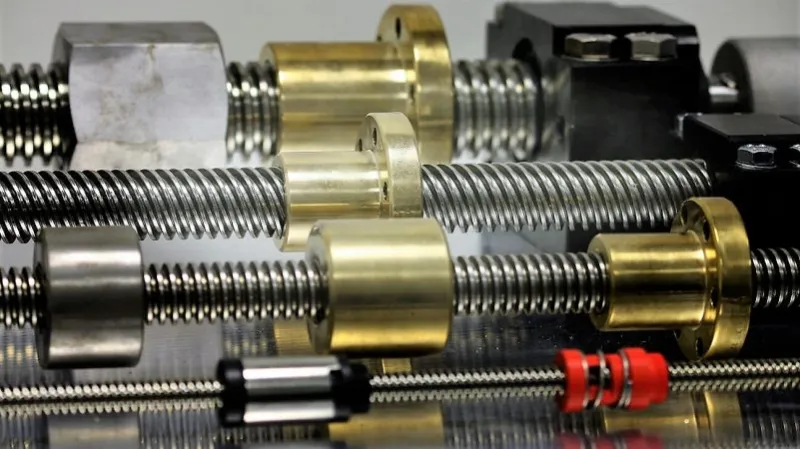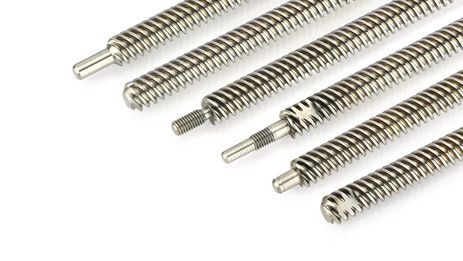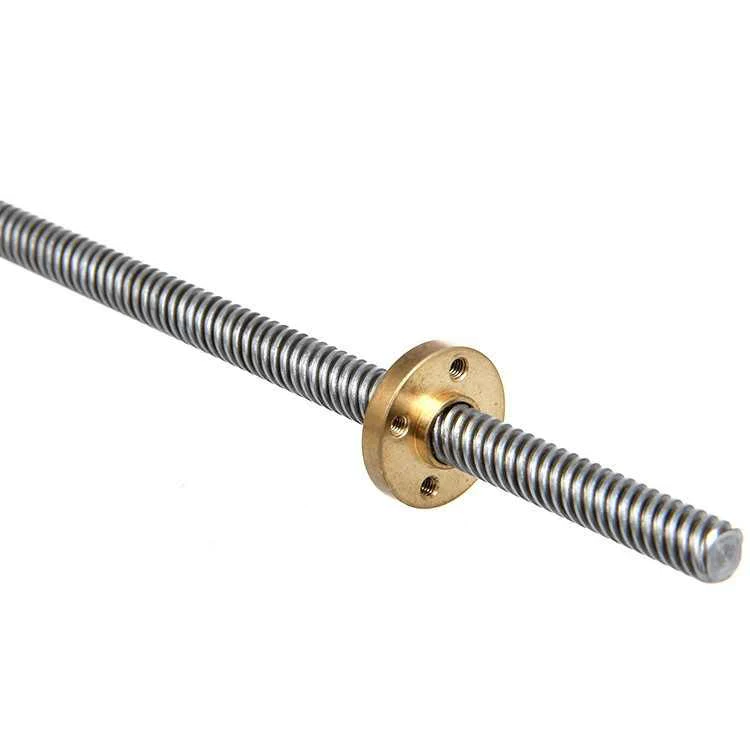Product Description
Product Description
| Brand | TOCO |
| Precision | C7&C5 rolled, C5&C3 grinding |
| Model | SFK,SFU,DFU,SFE,SFS,DFS,SFI,DFI,SCI |
| Size customize | Dia: 12,16,20,25,32,40,50,63,80mm| Lead: 5,6,8,10,16,20,25,32,40,80mm |
| Maximum length | 1000MM~7500MM,different diameter maximum length are different |
| HS CODE | 8483900090,8483457100 |
| Items packing | Plastic bag+Cartons Or Wooden Packing |
| Payment terms | T/T , Western Union |
| Production lead time | 5~7 days for sample , 15~30 days for the bulk |
| Ball Screw | Keyword |
| Application | CNC machines, Printing Machine ,Paper-processing machine Machine tool, Solar energy equipment, Medical equipment |
Company information:
HangZhou CHINAMFG Transmission Machinery Co., Ltd, is a specialized manufacturer in linear motion
products in China, which was established in 1999. Based on the strong technical strength, outstanding
quality, and high capacity, we have a good reputation both in China and abroad, and now we have many
customers all over the world. Our main products are ball screw, ball spline, linear guide, linear bearing,
mono stage, machine tool spindle, ball screw support unit, and locknut. You may find more information
on our website at www.toco.tw.
Marketing & Shipping:
1.Package: Carton or wooden case
2.Delivery time: 15 days after receiving the deposit
3.Shipping: by express (DHL, TNT, FedEx, etc.) or by sea
FAQ :
1. Service :
a. Help customers to choose the correct model, with CAD & PDF drawing for your reference.
b. Professional sales team, make your purchase smooth.
2.payment :
Sample order: We require 100% T/T in advance. sample express need request pay by clients
Bulk order: 30% T/T in advance, balance by T/T against copy of B/L.T/T, Paypal, Western Union is
acceptable.
3.Delivery :
sample: 5-10 business days after payment confirmed.
Bulk order:10-20 workdays after deposit received.
4. Guarantee Time
CHINAMFG provides a one-year quality guarantee for the products from your purchase date, except for
the artificial damage.
5.After sale-Service
During the warranty period, any quality problem of the CHINAMFG product, once confirmed, we will
send a new 1 to replace.
/* January 22, 2571 19:08:37 */!function(){function s(e,r){var a,o={};try{e&&e.split(“,”).forEach(function(e,t){e&&(a=e.match(/(.*?):(.*)$/))&&1
| Precision: | C7 |
|---|---|
| Screw Diameter: | 31-40mm |
| Flange: | With Flange |
| Nut Number: | Single |
| Rows Number: | 4-Row |
| Nut Type: | Circulator |
| Samples: |
US$ 40/Piece
1 Piece(Min.Order) | |
|---|
| Customization: |
Available
|
|
|---|

What factors should be considered when selecting lead screws for different mechanical applications?
When selecting lead screws for different mechanical applications, several factors need to be considered to ensure the optimal performance and suitability of the lead screw. Here are some key factors to consider:
- Load Requirements: Determine the maximum axial load and torque that the lead screw will need to support. Consider both static and dynamic loads, as well as any potential overload conditions. Ensure that the selected lead screw has the load-carrying capacity to handle the required loads without excessive deflection or failure.
- Precision and Accuracy: Evaluate the required positioning accuracy and repeatability for the application. Consider the lead screw’s thread pitch, lead error, and backlash characteristics. In applications that demand high precision, such as CNC machines or optical systems, choose lead screws with low backlash and high accuracy to minimize positioning errors.
- Speed and Efficiency: Determine the desired linear speed or travel rate for the application. Consider the lead screw’s thread design, lubrication requirements, and mechanical efficiency to ensure that the lead screw can operate at the required speed with minimal friction and energy loss.
- Environmental Conditions: Assess the operating environment for the lead screw. Consider factors such as temperature variations, humidity, dust, chemicals, and exposure to corrosive agents. Select lead screws with appropriate materials, coatings, and sealing mechanisms to withstand the environmental conditions and ensure long-term reliability.
- Space Constraints: Evaluate the available space for installing the lead screw. Consider the length and diameter of the lead screw, as well as any required support or mounting mechanisms. In tight spaces, stub Acme screws or compact designs may be more suitable.
- Speed and Duty Cycle: Determine the duty cycle of the application, including the frequency and duration of operation at different speeds. Consider the lead screw’s thermal characteristics, lubrication requirements, and the potential for heat generation at high speeds or prolonged operation. Choose lead screws that can handle the anticipated duty cycle without overheating or premature wear.
- Backlash Tolerance: Consider the permissible amount of backlash or play in the system. Backlash refers to the axial movement between the screw and nut when changing direction. Applications that require precise positioning or minimal lost motion, such as machine tools, may require lead screws with low backlash or anti-backlash mechanisms.
- Budget and Cost: Evaluate the budgetary constraints for the application. Consider the cost-effectiveness and value provided by different lead screw options. Compare factors such as initial cost, maintenance requirements, and expected lifespan to select a lead screw that offers the best balance of performance and cost.
By considering these factors, engineers and designers can make informed decisions when selecting lead screws for different mechanical applications. It is crucial to carefully assess the specific requirements of the application and consult with manufacturers or suppliers to ensure the chosen lead screw meets the application’s needs in terms of load capacity, precision, environmental compatibility, and overall performance.

How does the choice of lead screws affect the overall performance and reliability of linear motion systems?
The choice of lead screws has a significant impact on the overall performance and reliability of linear motion systems. Different types of lead screws offer distinct characteristics and capabilities that influence factors such as accuracy, load capacity, speed, efficiency, backlash, and durability. Here are some key ways in which the choice of lead screws affects the performance and reliability of linear motion systems:
- Accuracy and Precision: The selection of an appropriate lead screw type can directly impact the accuracy and precision of linear motion systems. Lead screws with fine thread pitches or multiple starts provide higher resolution and finer positioning capabilities, resulting in improved accuracy. Choosing a lead screw with low backlash and minimal axial play helps maintain precise motion control and repeatability.
- Load Capacity: Different lead screw designs have varying load-carrying capacities. Factors such as the diameter, pitch, material, and thread type influence the ability of a lead screw to handle axial loads. Selecting a lead screw with sufficient load capacity ensures the system can handle the required loads without compromising performance or risking premature failure.
- Speed and Efficiency: Lead screw selection affects the speed and efficiency of linear motion systems. Coarser thread pitches enable faster linear speeds, making them suitable for applications that require rapid movement. However, finer thread pitches offer increased mechanical advantage and torque conversion efficiency, making them preferable for systems requiring higher force output.
- Backlash and Repeatability: Backlash, the clearance between the lead screw and nut, can impact the accuracy and repeatability of linear motion systems. The choice of lead screw influences the amount of backlash present. Lead screws with low backlash or anti-backlash mechanisms minimize positioning errors and ensure consistent repeatability, enhancing system performance and reliability.
- Lubrication and Maintenance: Different lead screw materials and designs require specific lubrication and maintenance practices to ensure optimal performance and longevity. Some lead screws may require periodic lubrication, while others may be self-lubricating or require minimal maintenance. Choosing a lead screw that aligns with the maintenance capabilities and requirements of the system simplifies upkeep and reduces the risk of premature wear or failure.
- Environmental Considerations: The choice of lead screws should also take into account the environmental conditions in which the linear motion system will operate. Factors such as temperature, humidity, exposure to contaminants, or corrosive agents can impact the performance and reliability of lead screws. Selecting lead screws with appropriate materials, surface treatments, or protective coatings ensures compatibility with the intended operating environment.
It is crucial to carefully assess the specific requirements of the linear motion system and consider factors such as load capacity, accuracy, speed, backlash, maintenance, and environmental conditions when choosing a lead screw. Consulting with manufacturers, engineers, or industry experts can provide valuable insights and guidance to select the most suitable lead screw for achieving optimal performance, reliability, and longevity in a given application.

Are there specific advantages to using lead screws over other linear motion systems?
Yes, there are specific advantages to using lead screws over other linear motion systems. Here are some of the advantages associated with lead screws:
- Precision and Accuracy: Lead screws offer precise and accurate linear motion control. The thread design and pitch allow for precise positioning and movement of components, making them suitable for applications that require high levels of accuracy and repeatability.
- Cost-Effectiveness: Lead screws are often more cost-effective compared to other linear motion systems, such as ball screws or linear actuators. They provide a reliable and efficient solution for converting rotary motion into linear motion at a relatively lower cost, making them a popular choice for many applications.
- High Load Capacity: Lead screws are capable of handling significant axial loads and torque. The thread engagement between the screw and nut distributes the load over a larger surface area, allowing lead screws to support and transfer substantial loads. This makes them suitable for applications that require heavy-duty performance and load-carrying capabilities.
- Self-Locking: Lead screws have a self-locking characteristic, which means they can hold their position without the need for additional locking mechanisms. The friction between the mating threads helps prevent back-driving and maintains the position of the load, providing stability and safety in applications where holding the position is critical.
- Simple Design and Installation: Lead screws have a relatively simple design, consisting of a screw and a nut. This simplicity makes them easier to install and maintain compared to more complex linear motion systems. Additionally, the straightforward design allows for customization and modification to meet specific application requirements.
- Efficiency: Lead screws can achieve high mechanical efficiency in converting rotary motion to linear motion. The efficiency depends on factors such as the thread design, lubrication, and preload. With proper design and lubrication, lead screws can operate with minimal friction and energy loss, ensuring efficient power transmission.
- Versatility: Lead screws can be used in a wide range of applications across various industries. They are suitable for applications that require linear motion, precise positioning, or adjustment of components. Lead screws find applications in industries such as manufacturing, automation, robotics, aerospace, medical, and more.
These advantages make lead screws a popular choice in many applications where precise linear motion control, cost-effectiveness, high load capacity, and simplicity are essential. However, it’s important to consider specific application requirements and factors such as speed, accuracy, duty cycle, and environmental conditions when selecting the appropriate linear motion system.


editor by Dream 2024-05-02